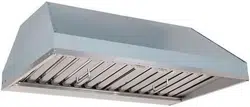Loading ...
Loading ...
Loading ...

- 9 -
15. LIGHT BULBS
This power pack must use shielded halogen lamps (120 V, 50 W PAR16 with GU10 base, 2 for CPDI362 and 4 for the
CPDI482 & CPDI602), included.
NOTE: Before using lamps, remove shipping tape on them (if present).
1. Install the lamps by placing the bulb leads into their grooves in the socket.
2. Gently push upwards and turn clockwise until secure.
To remove lamps, gently push upwards and turn counterclockwise to disengage bulb leads from their grooves.
NOTE: If need be, use a rubber dishwashing glove to add grip when removing the bulb; or use suction cup tool available from
BEST
®
to ease removal of the bulbs. Contact BEST
®
Technical Support at 1-800-637-1453 to order suction cup tool,
part number 99526707.
VQ0010
!
WARNING
In order to prevent the risk of personal injury, do not install a lamp
not suitable for use in enclosed fixtures.
12
HO0090
VQ0010
!
WARNING
In order to prevent the risk of personal injury, do not install a lamp
not suitable for use in enclosed fixtures.
Hood Liner Cleaning
Stainless steel cleaning:
Do:
• Regularly wash with clean cloth or rag soaked with warm
water and mild soap or liquid dish detergent.
• Always clean in the direction of original polish lines.
• Always rinse well with clear water (2 or 3 times) after
cleaning. Wipe dry completely.
• You may also use a specialized household stainless steel
cleaner
Don’t:
• Use any steel or stainless steel wool or any other scrapers
to remove stubborn dirt.
• Use any harsh or abrasive cleansers.
• Allow dirt to accumulate.
• Let plaster dust or any other construction residues reach
the hood. During construction/renovation, cover the power
pack to make sure no dust sticks to stainless steel surface.
Avoid when choosing a detergent:
- Any cleaners that contain bleach will attack stainless steel.
- Any products containing: chloride, fluoride, iodide, bromide will deteriorate surfaces rapidly.
- Any combustible products used for cleaning such as acetone, alcohol, ether, benzol, etc., are highly explosive and should
never be used close to a range.
16. USE AND CARE
Baffle Filters
The baffle filters should be cleaned frequently. Use a warm detergent solution. Wash more often if your cooking style generates
greater grease — like frying foods or wok cooking.
Remove baffle filters by pushing them towards the front of hood liner and rotating filters downward. Baffle filters are dishwasher
safe. Allow filters to dry completely before reinstalling them.
Clean all-metal filters in the dishwasher using a non-phosphate detergent. Discoloration of the filter may occur if using
phosphate detergent or as a result of local water conditions — but this will not affect filter performance. This discoloration is not
covered by the warranty.
Grease Drip Rail
The grease drip rail should be cleaned frequently. Remove it from the hood liner (see step 6 on page 6) and use a warm detergent
solution. As with the baffle filters, wash more often if your cooking style generates greater grease — like frying foods or wok
cooking. Allow grease drip rail to dry completely before reinstalling it.
Interior Blowers Cleaning
Remove the filters in order to access the blowers. Vacuum blowers to clean. Do not immerse in water.
Loading ...
Loading ...
Loading ...
